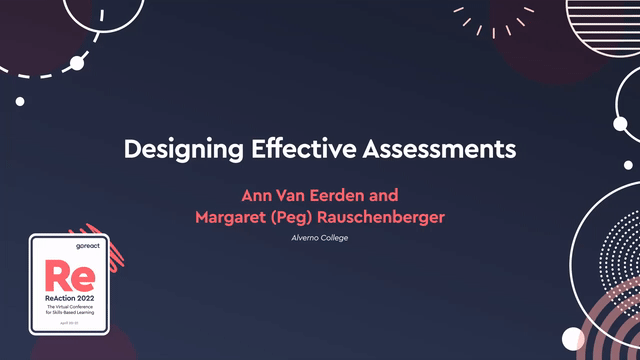So here’s where we’re going to get into an assessment design and competency-based education. So when you’re designing a performance assessment for a course, we would begin by asking, how do you take those outcomes and turn them into something concrete and observable that the students could be expected to do? To do this, you can create learning and assessment experiences and develop criteria, all of which are explicitly linked to those student learning outcomes.
A performance-based assessment is an example of student assessment as learning, which is what Peg was just differentiating a couple slides ago. It is a multidimensional process that’s integral to learning and involves observing performances of an individual learner in action and judging them on the basis of public developmental criteria– again, the criteria is public– with resulting feedback to the learning. So It serves to confirm student achievement and provide feedback to the student for the improvement of learning and to the instructor for the improvement of teaching.
So where to start? First, identify the assessment, context, or situation. Consider having a conference with the patient’s family about palliative care, safely using appropriate solutions to reconstitute a medication, observing children to identify developmental milestones, videotaping a group interaction, discussing a quality improvement project. So these are all contexts or situations that could be used as part of assessment design.
Next, you have to identify a mode for student response. Will it be written? Will it be oral? Will it be visual? What do you want students to do or produce as a part of this assessment?
Examples include something as basic or traditional as writing your research report. But it also could be making an oral presentation, writing a script, doing a role play in front of the class, creating a poster, writing a self-assessment and peer assessments of others’ effectiveness in accomplishing a group project, creating a movie that captures elements of a specific SBAR, creating a written community health teaching plan, or orally discussing the rationale. And then, finally, once you’ve identified A and B, you would create the assessment prompt and instructions. Next slide please.
As you design this assessment, questions to keep in mind are, how close is the assessment to what the students will actually do when they complete the program? Is the assessment clearly related to the outcomes and competencies? Does the assessment fit the level of the student? Does the assessment elicit the most advanced performance of which each student is capable? And does it include directions that are distinguished from the criteria?





